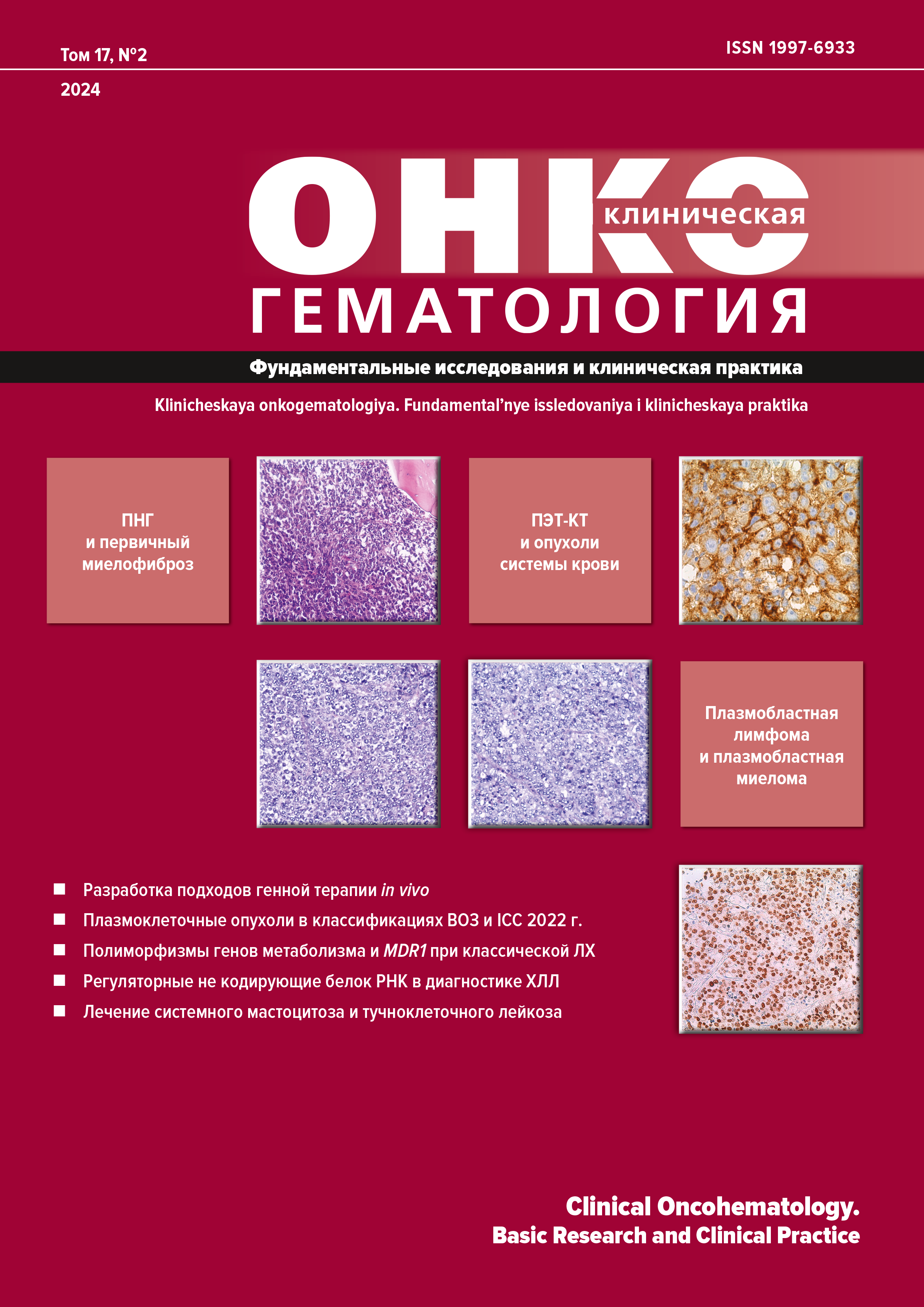Аннотация
Актуальность. Генная терапия на основе трансплантации кроветворных клеток становится мощной и универсальной стратегией лечения все более расширяющегося спектра различных заболеваний человека. Одна из актуальных проблем при внедрении технологий модификации генома в гемопоэтических стволовых клетках (ГСК) в клиническую практику — обеспечение качества и безопасности продуктов генной и клеточной терапии при их использовании у человека. Это достигается путем тестирования на животных моделях на этапе доклинических исследований. В этом отношении линия мышей NBSGW представляется уникальной и перспективной моделью, которая позволяет обеспечивать приживление ГСК человека без предварительного кондиционирования.
Цель. Апробация модели мышей NBSGW для приживления ГСК человека, оптимизация методов оценки состояния животных и мониторинга уровня химеризма для трансляционной доклинической разработки продуктов генной и клеточной терапии на основе ГСК.
Материалы и методы. Для создания моделей ксенотрансплантатов мышей NBSGW использовали образцы отобранных CD34+ ГСК периферической крови здорового донора. Серийную трансплантацию проводили методом внутривенной инъекции клеток костного мозга от первичных реципиентов с высоким уровнем химеризма. Эффективность приживления оценивали методами проточной цитофлюориметрии (ПЦФ) и цифровой капельной полимеразной цепной реакции (цкПЦР). Субпопуляционный состав приживления клеток человека оценивали с помощью ПЦФ.
Результаты. Апробированный протокол трансплантации ГСК отличается благоприятным профилем токсичности. По результатам ПЦФ у всех мышей исследуемой выборки отмечалось долгосрочное приживление клеток человека с высоким уровнем химеризма (23,5–93,6 %) в костном мозге животных, в т. ч. после серийной трансплантации, что было подтверждено данными цкПЦР. Зафиксировано преобладание клеток B-линейной дифференцировки во всех протестированных образцах (периферической крови, костного мозга, селезенки) мышей после первичной и серийной трансплантаций. Метод цкПЦР может использоваться как дополнительный способ валидации данных об уровне приживления клеток человека, полученных с помощью ПЦФ.
Заключение. Мыши NBSGW являются перспективной базовой моделью доклинической разработки продуктов генной и клеточной терапии на основе первичных ГСК человека с модифицированным геномом.
Библиографические ссылки
- Koniali L, Lederer CW, Kleanthous M. Therapy development by genome editing of hematopoietic stem cells. Cells. 2021;10(6):1492. doi: 10.3390/cells10061492.
- Cring MR, Sheffield VC. Gene therapy and gene correction: targets, progress, and challenges for treating human diseases. Gene Ther. 2022;29(1–2):3–12. doi: 10.1038/s41434-020-00197-8.
- Sagoo P, Gaspar HB. The transformative potential of HSC gene therapy as a genetic medicine. Gene Ther. 2023;30(3–4):197–215. doi: 10.1038/s41434-021-00261-x.
- Morgan RA, Gray D, Lomova A, Kohn DB. Hematopoietic stem cell gene therapy: progress and lessons learned. Cell Stem Cell. 2017;21(5):574–90. doi: 10.1016/j.stem.2017.10.010.
- Radtke S, Humbert O, Kiem HP. Mouse models in hematopoietic stem cell gene therapy and genome editing. Biochem Pharmacol. 2020;174:113692. doi: 10.1016/j.bcp.2019.113692.
- Mian SA, Anjos-Afonso F, Bonnet D. Advances in Human Immune System Mouse Models for Studying Human Hematopoiesis and Cancer Immunotherapy. Front Immunol. 2021;11:619236. doi: 10.3389/fimmu.2020.619236.
- McDermott SP, Eppert K, Lechman ER, et al. Comparison of human cord blood engraftment between immunocompromised mouse strains. Blood. 2010;116(2):193–200. doi: 10.1182/blood-2010-02-271841.
- McIntosh BE, Brown ME, Duffin BM, et al. Nonirradiated NOD,B6.SCID Il2rγ-/- Kit(W41/W41) (NBSGW) mice support multilineage engraftment of human hematopoietic cells. Stem Cell Reports. 2015;4(2):171–80. doi: 10.1016/j.stemcr.2014.12.005.
- Sun G, Liang X, Qin K, et al. Functional analysis of KIT gene structural mutations causing the porcine dominant white phenotype using genome edited mouse models. Front Genet. 2020;11:138. doi: 10.3389/fgene.2020.00138.
- Rojas-Sutterlin S, Lecuyer E, Hoang T. Kit and Scl Regulation of Hematopoietic Stem Cells. Curr Opin Hematol. 2014;21(4):256–64. doi: 10.1097/moh.0000000000000052.
- Cosgun KN, Rahmig S, Mende N, et al. Kit regulates HSC engraftment across the human-mouse species barrier. Cell Stem Cell. 2014;15(2):227–38. doi: 10.1016/j.stem.2014.06.001.
- Theocharides AP, Rongvaux A, Fritsch K, et al. Humanized hemato-lymphoid system mice. Haematologica. 2016;101(1):5–19. doi: 10.3324/haematol.2014.115212.
- Ito M, Hiramatsu H, Kobayashi K, et al. NOD/SCID/gamma(c)(null) mouse: an excellent recipient mouse model for engraftment of human cells. Blood. 2002;100(9):3175–82. doi: 10.1182/blood-2001-12-0207.
- Pattabhi S, Lotti SN, Berger MP, et al. In vivo outcome of homology-directed repair at the HBB gene in HSC using alternative donor template delivery methods. Mol Ther Nucleic Acids. 2019;17:277–88. doi: 10.1016/j.omtn.2019.05.025.
- Wu Y, Zeng J, Roscoe BP, et al. Highly efficient therapeutic gene editing of human hematopoietic stem cells. Nat Med. 2019;25(5):776–83. doi: 10.1038/s41591-019-0401-y.
- Metais JY, Doerfler PA, Mayuranathan T, et al. Genome editing of HBG1 and HBG2 to induce fetal hemoglobin. Blood Adv. 2019;3(21):3379–92. doi: 10.1182/bloodadvances.2019000820.
- Everette KA, Newby GA, Levine RM, et al. Ex vivo prime editing of patient haematopoietic stem cells rescues sickle-cell disease phenotypes after engraftment in mice. Nat Biomed Eng. 2023;7(5):616–28. doi: 10.1038/s41551-023-01026-0.
- Leonard A, Yapundich M, Nassehi T, et al. Low-dose busulfan reduces human CD34(+) cell doses required for engraftment in c-kit mutant immunodeficient mice. Mol Ther Methods Clin Dev. 2019;15:430–7. doi: 10.1016/j.omtm.2019.10.017.
- Hess NJ, Lindner PN, Vazquez J, et al. Different human immune lineage compositions are generated in non-conditioned NBSGW mice depending on HSPC source. Front Immunol. 2020;11:573406. doi: 10.3389/fimmu.2020.573406.
- Adigbli G, Hua P, Uchiyama M, et al. Development of LT-HSC- reconstituted nonirradiated NBSGW mice for the study of human hematopoiesis in vivo. Front Immunol. 2021;12:642198. doi: 10.3389/fimmu.2021.642198.
- Amoah A, Keller A, Emini R, et al. Aging of human hematopoietic stem cells is linked to changes in Cdc42 activity. Haematologica 2022;107(2):393–402. doi: 10.3324/haematol.2020.269670.
- Karuppusamy KV, Demosthenes JP, Venkatesan V, et al. The CCR5 gene edited CD34+CD90+ hematopoietic stem cell population serves as an optimal graft source for HIV gene therapy. Front Immunol. 2022;13:792684. doi: 10.3389/fimmu.2022.792684.
- Magis W, DeWitt MA, Wyman SK, et al. High-level correction of the sickle mutation is amplified in vivo during erythroid differentiation. iScience 2022;25(6):104374. doi: 10.1016/j.isci.2022.104374.
- Suchy FP, Nishimura T, Seki S, et al. Streamlined and quantitative detection of chimerism using digital PCR. Sci Rep. 2022;12(1):10223. doi: 10.1038/s41598-022-14467-5.
- Maganti HB, Bailey AJM, Kirkham AM, et al. Persistence of CRISPR/Cas9 gene edited hematopoietic stem cells following transplantation: A systematic review and meta-analysis of preclinical studies. Stem Cells Transl Med. 2021;10(7):996–1007. doi: 10.1002/sctm.20-0520.
- Fiorini C, Abdulhay NJ, McFarland SK, et al. Developmentally-faithful and effective human erythropoiesis in immunodeficient and Kit mutant mice. Am J Hematol. 2017;92(9):Е513–E519. doi: 10.1002/ajh.24805.

Это произведение доступно по лицензии Creative Commons «Attribution-NonCommercial-ShareAlike» («Атрибуция — Некоммерческое использование — На тех же условиях») 4.0 Всемирная.
Copyright (c) 2024 Клиническая онкогематология
